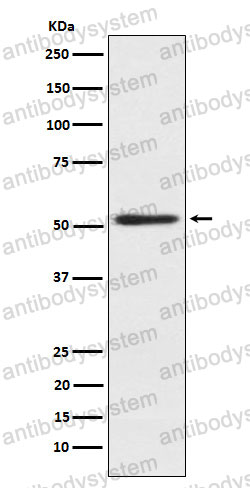Catalog No.
RHF39301
Species reactivity
Human, Mouse, Rat
Host species
Rabbit
Isotype
IgG
Clonality
Monoclonal
Tested applications
FCM: 1:20-1:100, IHC: 1:100-1:200, IP: 1:20-1:50, WB: 1:1000-1:2000
Target
Signal recognition particle 54 kDa protein, SRP54
Concentration
1 mg/ml
Endotoxin level
Please contact with the lab for this information.
Purity
>95% by SDS-PAGE.
Purification
Protein A/G purified from cell culture supernatant.
Accession
P61011
Applications
FCM, IHC, IP, WB
Form
Liquid
Storage buffer
0.01M PBS, pH 7.4, 0.05% BSA, 50% Glycerol, 0.05% Sodium azide.
Stability and Storage
Use a manual defrost freezer and avoid repeated freeze thaw cycles. Store at 4 ℃ for frequent use. Store at -20 ℃ for twelve months from the date of receipt.
Clone ID
R1Z92
Profiling of Anti-Signal-Recognition Particle Antibodies and Clinical Characteristics in South Korean Patients With Immune-Mediated Necrotizing Myopathy., PMID:39778565
Case study of CD19 CAR T therapy in a subject with immune-mediate necrotizing myopathy treated in the RESET-Myositis phase I/II trial., PMID:39245937
Endoplasmic reticulum-stress and unfolded protein response-activation in immune-mediated necrotizing myopathy., PMID:35703068
Cancer and immune-mediated necrotizing myopathy: a longitudinal referral case-controlled outcomes evaluation., PMID:35285492
Clinical Course, Myopathology and Challenge of Therapeutic Intervention in Pediatric Patients with Autoimmune-Mediated Necrotizing Myopathy., PMID:34572153
DDX3 modulates the tumor microenvironment via its role in endoplasmic reticulum-associated translation., PMID:34568799
Pathology Features of Immune and Inflammatory Myopathies, Including a Polymyositis Pattern, Relate Strongly to Serum Autoantibodies., PMID:34363679
Congenital neutropenia with variable clinical presentation in novel mutation of the SRP54 gene., PMID:32277798
Novel gene variants associated with cardiovascular disease in systemic lupus erythematosus and rheumatoid arthritis., PMID:29514802
Signal recognition particle immunoglobulin g detected incidentally associates with autoimmune myopathy., PMID:26561982
Anti-signal recognition particle antibody in patients without inflammatory myopathy: a survey of 6180 patients with connective tissue diseases., PMID:26312949
Inflammatory myopathy with anti-signal recognition particle antibodies: case series of 100 patients., PMID:25963141
Serum levels of anti-SRP54 antibodies reflect disease activity of necrotizing myopathy in a child treated effectively with combinatorial methylprednisolone pulses and plasma exchanges followed by intravenous cyclophosphamide., PMID:24506571
Implication of the SMN complex in the biogenesis and steady state level of the signal recognition particle., PMID:23221635
Correlation of anti-signal recognition particle autoantibody levels with creatine kinase activity in patients with necrotizing myopathy., PMID:21400483
[Histological and molecular alterations in inflammatory myopathies]., PMID:21794664
Human autoantibodies against the 54 kDa protein of the signal recognition particle block function at multiple stages., PMID:16469117
Signal recognition particle components in the nucleolus., PMID:10618370
Yarrowia lipolytica SRP54 homolog and translocation of Kar2p., PMID:9178502
Characterization of a chloroplast homologue of the 54-kDa subunit of the signal recognition particle., PMID:8408079
flhF, a Bacillus subtilis flagellar gene that encodes a putative GTP-binding protein., PMID:1447978
Fluorescence-detected assembly of the signal recognition particle: binding of the two SRP protein heterodimers to SRP RNA is noncooperative., PMID:1377027
The signal sequence interacts with the methionine-rich domain of the 54-kD protein of signal recognition particle., PMID:1849137

